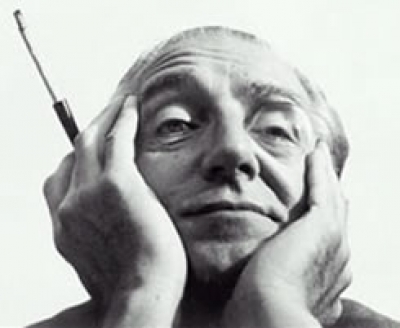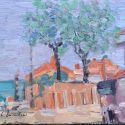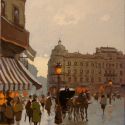
Biography
Early life and career
Metropolis - Lang's famous 1927 science fiction movie
Born in Vienna, Lang grew up the second son of an architect. Both his father and his mother were practising Roman Catholics, as was Lang himself; indeed he was baptized in the Schottenkirche near his family's home. Lang took up civil engineering at the Technical University of Vienna but was not enthusiastic about it and switched studies to art in 1908. In 1910 and 1911 he left Vienna to see the world, traveling to Africa and later Asia and the Pacific area. At the outbreak of the First World War he was drafted into service in the Austrian-Hungarian army and fought in World War I, where he was wounded several times. After recovering from injuries and shell shock he was discharged as lieutenant from the army.
After the war he joined Germany's Ufa studio just as the Expressionist movement was waxing. In this first phase of his career, Lang alternated between art films such as Der Müde Tod (The Weary Death) and populist thrillers such as Die Spinnen (The Spiders) (a two-part film), combining popular genres with Expressionist techniques to create an unprecedented synthesis of popular entertainment with art cinema, culminating in his most famous silent works: Dr. Mabuse, der Spieler (Dr. Mabuse, the Gambler) (1922), a crime epic (running four hours in two parts in its original version, recently restored by the Munich Filmmuseum) focusing on the psychological conflict between the master criminal Mabuse and detective Von Wenk; Die Nibelungen (1924), and his most famous film, Metropolis (1927).
The Goebbels myth
Many of the stories about Lang's life and career are hard to verify, including perhaps the most famous Lang story of all. The legend has it that Joseph Goebbels called Lang to his offices for a meeting in which he gave Lang two pieces of news: the first was that his most recent film, Das Testament des Dr. Mabuse (The Testament of Dr. Mabuse) was being banned as an incitement to public disorder. The second was that he was nevertheless so impressed by Lang's abilities as a filmmaker, he was offering Lang a position as the head of German film. Lang had been, unbeknownst to Goebbels, already planning to leave Germany for Paris, but the meeting with Goebbels ran so long that the banks were closed by the time it finished, and Lang fled that night without his money, not to return until after the war.
The problem is that many portions of the story cannot be checked, and of those that can, most are contradicted by the evidence. Lang actually left Germany with most of his money, unlike most refugees, and made several return trips later in the same year. There were of course no witnesses to the meeting besides Goebbels and Lang, but Goebbels's appointment books, when they refer to the meeting, mention only the banning of Testament. No evidence has been discovered in any of Goebbels's writings to affirm the suggestion that he was planning to offer Lang any position. Whatever the truth of this legend, it is known that Lang did in fact leave Germany in 1934 and moved to Paris and later to the United States. His wife Thea von Harbou had started to symphathize with the Nazis in the early 1930s and stayed behind. She joined the NSDAP (Nazi Party) in 1932, leading to a divorce the following year.
The aging Lang appeared as himself in Jean-Luc Godard's film Contempt (1964) in which the barest outline of this story is presented as fact.
Metropolis, M and his life in America
Fritz Lang's M is one of the most important early film noir works
Although some consider Lang's work to be simple melodrama, he produced a coherent oeuvre that helped to establish the characteristics of film noir, with its recurring themes of psychological conflict, paranoia, fate and moral ambiguity. His work influenced filmmakers as disparate as Jacques Rivette and William Friedkin.
In 1931, between Metropolis and Das Testament des Dr. Mabuse, Lang directed what many film scholars consider to be his masterpiece: M, a disturbing story of a child murderer (Peter Lorre in his first starring role) who is hunted down and brought to trial by Berlin's criminal underworld. M remains a powerful work; it was remade in 1951 by Joseph Losey, but this version had little impact on audiences, and has become harder to see than the original film.
Upon his arrival in Hollywood, Lang joined the MGM studio and directed the impressive crime drama Fury. He became a naturalized citizen of the United States in 1939. Lang made twenty-one features in the next twenty-one years, working in a variety of genres at every major studio in Hollywood, occasionally producing his films as an independent. These films, often compared unfavourably by contemporary critics to Lang's earlier works, have since been reevaluated as being integral to the emergence and evolution of American genre cinema, film noir in particular. During this period, his visual style simplified (owing in part to the constraints of the Hollywood studio system) and his worldview became increasingly pessimistic, culminating in the cold, geometric style of his last American films, While the City Sleeps (1956) and Beyond a Reasonable Doubt (1957).
Lang as a director
Lang epitomized the stereotype of the tyrannical German film director such as Erich von Stroheim and Otto Preminger; he was known for being hard to work with. During the climactic final scene in M, he allegedly threw Peter Lorre down a flight of stairs in order to give more authenticity to Lorre's battered look. He wore a monocle that added to the stereotype (though film historians say this particular cliché began with von Stroheim), and his image has been parodied in a number of media, including GWAR's long form video Phallus in Wonderland.
Late work and death
During the 1950s, Lang found it harder to find congenial production conditions in Hollywood and his advancing age left him less inclined to grapple with American backers. The German producer, Artur Brauner, was expressing interest in remaking not only The Indian Tomb (a story that Lang had developed in the twenties that was ultimately taken from him by studio heads and directed instead by Joe May) but Lang's earlier Doctor Mabuse pictures. Fearing that Brauner would proceed with or without his assent, Lang abandoned his plans for retirement and returned to Germany in order to make his Indian Epic, which is regarded as a masterpiece by a number of film scholars today. Following the production, Brauner was ready to proceed with his remake of Das Testament des Doctor Mabuse when Lang approached him with the idea of adding another original film to the series. The result was Die Tausend Augen des Dr. Mabuse (The Thousand Eyes of Dr. Mabuse), made in a hurry and with a relatively small budget. It can be viewed as the marriage between the director's early experiences with expressionist techniques in Germany as well as the spartan style already visible in his late American work. Lang was approaching blindness during the production, making it his final project.
Returning to the United States in retirement, he continued collecting research material and drafting screenplays, though he never made another film. While his career had ended without fanfare, his work went through a reappraisal in later years following Jean-Luc Godard's decision to cast him in his film Le Mépris in addition to considerable critical adulation in the US from the likes of Peter Bogdanovich.
He died in 1976 and was interred in the Forest Lawn - Hollywood Hills Cemetery in Los Angeles.
Trivia
Fritz Lang was portrayed in the movie Fullmetal Alchemist: Conqueror of Shambala. In his first appearance in the film, he disguised himself as Mabuse, an elderly man, so that he could research and get inspiration for his next movie. Later on he is revealed to be himself, while talking with the movies's main character at the UFA studios at Babelsberg.
Filmography
Halbblut (The Half-Caste) (1919)
Die Spinnen, 1. Teil: Der Goldene See (Spiders, Part 1: The Golden Lake) (1919)
Harakiri (Madame Butterfly) (1919)
Die Pest in Florenz (The Plague in Florence) (1919)
Der Herr der Liebe (Master of Love) (1919)
Die Spinnen, 2. Teil: Das Brillantenschiff (Spiders, Part 2: The Diamond Ship) (1920)
Das Wandernde Bild (The Wandering Image) (1920)
Der müde Tod (Released in English as Beyond the Wall; the German title means "weary Death") (1921)
Vier um die Frau (Four Around a Woman) (1921)
Dr. Mabuse, der Spieler (Dr. Mabuse, The Gambler) (1922)
Die Nibelungen: Siegfried (Die Nibelungen: Siegfried) (1924)
Die Nibelungen: Kriemhilds Rache (Die Nibelungen: Kriemheld's Revenge) (1924)
Metropolis (1927)
Spione (Spies) (1928)
Frau im Mond (Woman in the Moon) (1929)
M (1931)
Das Testament des Dr. Mabuse (The Testament of Dr. Mabuse) (1933)
Liliom (1934)
Fury (1936)
You Only Live Once (1937)
You and Me (1938)
The Return of Frank James (1940)
Western Union (1941)
Man Hunt (1941)
Confirm or Deny (1941) (uncredited)
Moontide (1942) (uncredited)
Hangmen Also Die (1943)
Ministry of Fear (1944)
The Woman in the Window (1944)
Scarlet Street (1945)
Cloak and Dagger (1946)
Secret Beyond the Door (1948)
House by the River (1950)
American Guerrilla in the Philippines (1950)
Rancho Notorious (1952)
Clash by Night (1952)
The Blue Gardenia (1953)
The Big Heat (1953)
Human Desire (1954)
Moonfleet (1955)
While the City Sleeps (1956)
Beyond a Reasonable Doubt (1957)
Der Tiger von Eschnapur (The Tiger of Eschnapur, or: The Tiger of Bengal) (1959)
Das indische Grabmal (The Indian Tomb, or: Journey to the Lost City) (1959)
Die 1000 Augen des Dr. Mabuse (The Thousand Eyes of Dr. Mabuse) (1960)
See also
List of famous Austrians
Film noir
Expressionism
Metropolis

































